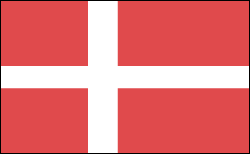Denmark | Facts & Information

- Denmark Profile
- History
- News and Current Events
Facts & Figures
-
Sovereign: Queen Margrethe II (1972)
Prime Minister: Lars Lokke Rasmussen (2015)
Land area: 16,359 sq mi (42,370 sq km); total area: 16,639 sq mi (43,094 sq km)1
Population (2014 est.): 5,569,077 (growth rate: 0.22%); birth rate: 10.22/1000; infant mortality rate: 4.1/1000; life expectancy: 79.09
Capital and largest city (2011 est.): Copenhagen, 1.206 million
Monetary unit: Krone
National name: Kongeriget Danmark
Languages: Danish, Faroese, Greenlandic (Inuit dialect), German; English is the predominant second language
Ethnicity/race: Scandinavian, Inuit, Faroese, German, Turkish, Iranian, Somali
National Holiday: Constitution Day, June 5
Religions: Evangelical Lutheran (official) 80%, Muslim 4%, other (denominations of less than 1% each, includes Roman Catholic, Jehovah's Witness, Serbian Orthodox Christian, Jewish, Baptist, and Buddhist) 16% (2012 est.)
Literacy rate: 99%
Economic summary: GDP/PPP (2013 est.): $211.3 billion; per capita $37,800. Real growth rate: 0.1%. Inflation: 0.8%. Unemployment: 6%. Arable land: 57.99%. Agriculture: barley, wheat, potatoes, sugar beets; pork, dairy products; fish. Labor force: 2.795 million; agriculture 2.6%, industry 20.3%, services 77.1% (2013 est.). Industries: iron, steel, nonferrous metals, chemicals, food processing, machinery and transportation equipment, textiles and clothing, electronics, construction, furniture and other wood products, shipbuilding and refurbishment, windmills, pharmaceuticals, medical equipment. Natural resources: petroleum, natural gas, fish, salt, limestone, stone, gravel and sand. Exports: $106 billion (2013 est.): machinery and instruments, meat and meat products, dairy products, fish, chemicals, furniture, ships, windmills. Imports: $98.45 billion (2013 est.): machinery and equipment, raw materials and semimanufactures for industry, chemicals, grain and foodstuffs, consumer goods. Major trading partners: Germany, Sweden, UK, U.S., Netherlands, Norway, China (2012).
Communications: Telephones: main lines in use: 2.431 million (2012); mobile cellular: 6.6 million (2012). Broadcast media:strong public-sector television presence with state-owned Danmarks Radio (DR) operating 4 channels and publicly-owned TV2 operating roughly a half dozen channels; broadcasts of privately-owned stations are available via satellite and cable feed; DR operates 4 nationwide FM radio stations, 15 digital audio broadcasting stations, and about 15 web-based radio stations; approximately 250 commercial and community radio stations are operational (2007). Internet hosts:4.297 million (2012). Internet users: 4.75 million (2009).
Transportation: Railways: total: 2,667 km km (2011). Highways: total: 73,197 km; paved: 73,197 km (includes 1,111 km of expressways) (2011). Waterways: 400 km (2010). Ports and harbors: Aalborg, Aarhus, Copenhagen, Ensted, Esbjerg, Fredericia, Kalundborg. Airports: 92 (2013 est.).
Transportation: Railways: total: 2,667 km km (2012). Highways: total: 73,929 km; paved: 73,929 km (includes 1,143 km of expressways) (2012). Waterways: 400 km (2010). Ports and harbors: Aalborg, Aarhus, Copenhagen, Ensted, Esbjerg, Fredericia, Kalundborg. Airports: 80 (2010 est.).
International disputes: Iceland, the UK, and Ireland dispute Denmark's claim that the Faroe Islands' continental shelf extends beyond 200 nm; Faroese continue to study proposals for full independence; sovereignty dispute with Canada over Hans Island in the Kennedy Channel between Ellesmere Island and Greenland; Denmark (Greenland) and Norway have made submissions to the Commission on the Limits of the Continental shelf (CLCS) and Russia is collecting additional data to augment its 2001 CLCS submission.









